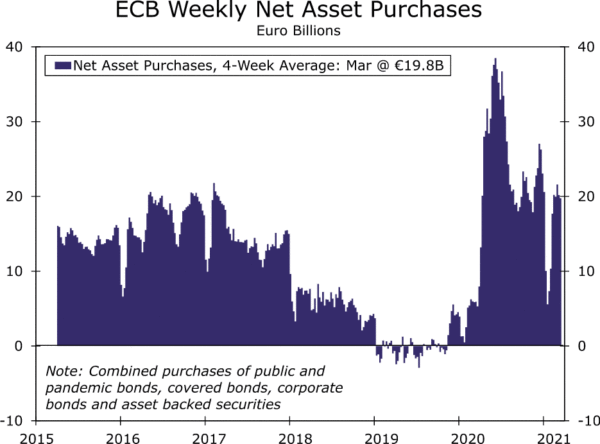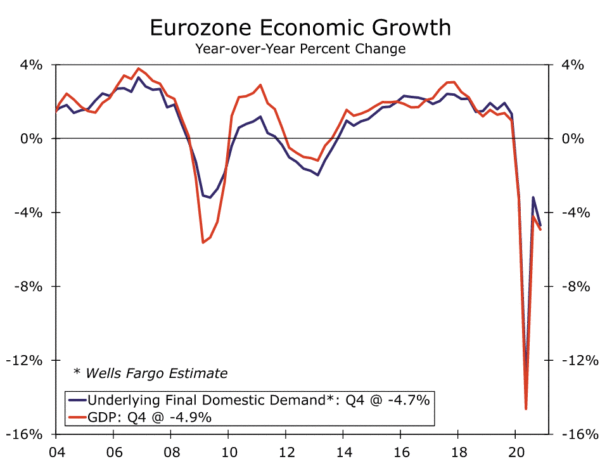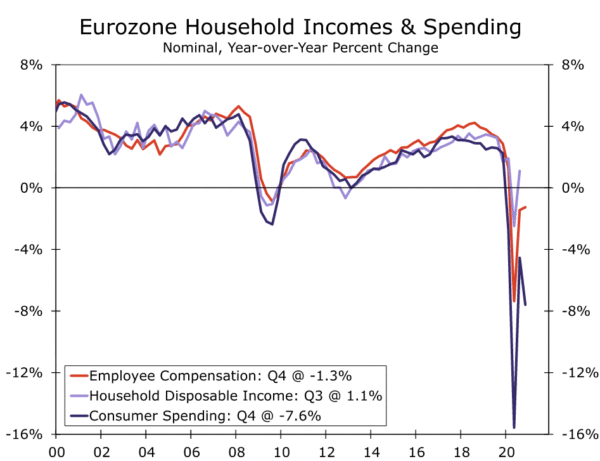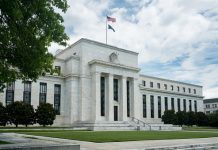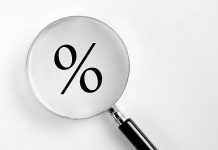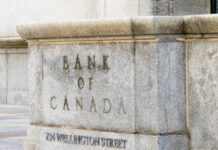Summary
- The European Central Bank (ECB) announced its latest monetary policy decision today. While policy interest rates and the total size of its Pandemic Emergency Purchase Program (PEPP) were left unchanged, the ECB did make one notable policy tweak. In an effort to offset rising bond yields and boost inflation prospects, the ECB said it will speed up PEPP asset purchases “at a significantly higher pace than during the first months of the year.” In our view, this tweak in policy is a dovish shift in monetary policy sentiment and signals the ECB’s commitment to keeping monetary policy ultra-accommodative for the foreseeable future.
- Updated ECB economic projections were also released this morning; however, forecast changes were less notable. Growth forecasts were essentially unchanged, while the 2021 inflation outlook was boosted to 1.5% from 1.0% previously.
- Seperately, we also received earlier this week a more detailed breakdown of Eurozone Q4 GDP data. Underlying details of the Eurozone economy reveal sluggish economic activity and it is likely the economy will contract again in Q1-2021. On the other hand, household balance sheets improved toward the end of last year, which suggests when COVID-related restrictions are lifted, the medium-term economic outlook could be supported by consumer spending.
- Given today’s dovish language from the ECB, we continue to believe the euro will be restrained in the short-term, and experience only modest gains over the longer-term. Today’s message is consistent with our recent downward revisions to our EUR/USD forecasts, and we continue to believe downside risks to our euro forecasts remain prevalent.
ECB Signals a Faster Pace of Bond Buying
The European Central Bank (ECB) announced its latest monetary policy decision today and, while it left its key policy parameters unchanged, it made some important tweaks that delivered a message that was overall dovish in tone. First, in terms of the key parameters that did not change, the ECB kept its Deposit Rate at -0.50% and maintained the size of its Pandemic Emergency Purchase Program (PEPP) at €1,850 billion. In addition, the central bank maintained a balanced and flexible approach regarding the use of PEPP purchases, saying the purchase envelope might not be used in full if financing conditions are favorable, but also that the purchase envelope could be increased if needed.
More notably, however, was one tweak within the ECB’s announcement that did change, and indeed is a new element that is absent from previous monetary policy decisions. The central bank commented that based “on a joint assessment of financing conditions and the inflation outlook, the Governing Council expects purchases under the PEPP over the next quarter to be conducted at a significantly higher pace than during the first months of this year.” This tweak comes after a steady series of comments from ECB policymakers in recent weeks, noting they were monitoring bond yields closely and indicating some concern about a premature rise in bond yields. The move in German 10-year government bond yields is modest but notable, with yields down three basis points to -0.34% today. The following chart shows total bond purchases by the ECB (although in recent months these have been dominated by PEPP purchases), and how the pace of bond buying has slowed noticeably since early 2022. In fact, focusing on the last two weeks for PEPP purchases alone, net buying during the period has averaged just €12 billion per week. While acknowledging that larger than usual redemptions have depressed the net purchase figures, clearly the ECB appears to have been somewhat less active than usual recently. We also observe the ECB has plenty of scope to increase the pace of its PEPP purchases within the current €1,850 billion envelope and still continue those purchases for an extended period. At a PEPP purchase pace of €20 billion per week the ECB would have 48 weeks of buying left, while at a PEPP purchase pace of €25 billion per week the ECB would have 39 weeks of buying left.
Finally, the ECB also provided updated economic projections, although there were only moderate changes from the previous outlook in December. The GDP growth forecasts are virtually identical, with 2021 GDP growth seen at 4.0% (versus 3.9% previously) and 2022 GDP growth seen at 4.1% (versus 4.2% previously). ECB President Lagarde also said risks have become more balanced. For CPI inflation, the 2021 forecast was lifted to 1.5% from 1.0% , but there were barely perceptible change to the inflation forecasts for 2022 and 2023.
Eurozone Q4 GDP Figure Reveal a Subdued Economic Underbelly
This week also saw the release of a detailed breakdown of Eurozone Q4 GDP data, indicating that domestic momentum with the region was noticeably subdued late last year. The headline Q4 GDP result showed a fall of 0.7% quarter-over-quarter and 4.9% year-over-year. At the same time, the details showed consumer spending fell 3.0% quarter-over-quarter, while investment spending excluding intellectual property (the latter being a volatile component), rose just 0.3%. As a result, our measure of underlying final domestic demand fell 1.6% quarter-over-quarter, more than the headline decline in Q4 GDP, an indication of modest domestic momentum. Like ourselves, the ECB also anticipates a further contraction in the Eurozone economy in Q1-2021.
In terms of a silver lining, and one does have to look pretty hard for one, Q4 saw employee compensation rise 0.6% quarter-over-quarter, following a surge in compensation in Q3. Combined with the drop in Q4 consumer spending, the likelihood is that the Eurozone household savings rate increased in Q4 from already historically elevated levels. That should leave European households well positioned to eventually drive a consumer recovery, but only once the economy is fully re-opened and the overall population is more fully vaccinated.
ECB’s Dovish Policy Bias to Persist, but Further Easing Not Yet Certain
Given the comments from ECB policymakers in recent weeks, and today’s “policy tweak,” it seems pretty clear to us that the ECB’s dovish monetary policy bias could persist for some time. Whether that leads to further monetary policy action, such as lower interest rates or another increase in the total size of the asset purchase program is not yet certain. Whether such policy action occurs could depend in large part on how robust the Eurozone’s medium-term economic recovery is and the speed of vaccine distribution across the region. Still, even a persistent dovish policy bias alone could be enough to act as a restraint on the euro for the time being. We recently revised our EUR/USD exchange rate forecast lower and expect only very modest gains over time, while we also continue to see downside risks to those downwardly revised euro forecasts.




